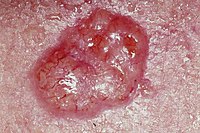
Photo from wikipedia
From the first report in 1969 to the present day, diagnosis of eccrine porocarcinoma, also known simply as porocarcinoma (PC), remains a challenge. This review presents a concise update of… Click to show full abstract
From the first report in 1969 to the present day, diagnosis of eccrine porocarcinoma, also known simply as porocarcinoma (PC), remains a challenge. This review presents a concise update of the history, pathogenesis, epidemiology, diagnosis, management and prognosis of this rare sweat gland neoplasm. It differentiates towards the intraepidermal spiral ducts in the eccrine gland, is more common in those over 60 years and often affects the head, neck and lower extremities. PC presents as a dome shaped papule, plaque or nodule growing over weeks to months. The exact incidence is unknown but appears to be rising. Diagnosis is difficult because of variable presentations and similar clinical and histological features to cutaneous squamous cell carcinoma. Management involves removal of the tumour, usually using wide local excision or Mohs micrographic surgery. Prognosis is poor with PC recurring after surgery in 35%. Given the lack of standardised protocols and risk profiles, further studies would help better the understanding of PC.
Journal Title: Clinical and experimental dermatology
Year Published: 2022
Link to full text (if available)
Share on Social Media: Sign Up to like & get
recommendations!